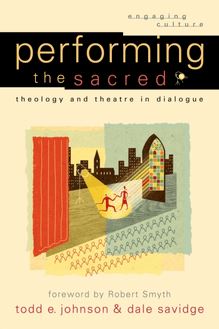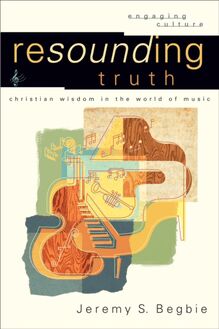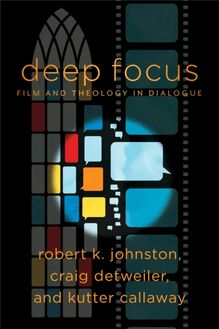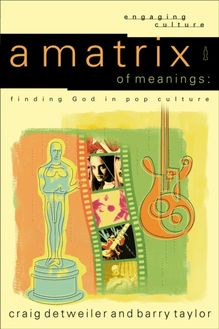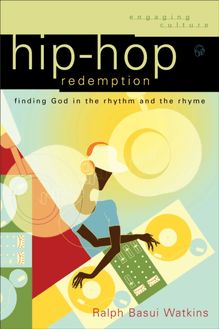Deep Focus (Engaging Culture) , livre ebook
130
pages
English
Ebooks
2019
Vous pourrez modifier la taille du texte de cet ouvrage
Obtenez un accès à la bibliothèque pour le consulter en ligne En savoir plus
Découvre YouScribe en t'inscrivant gratuitement
Découvre YouScribe en t'inscrivant gratuitement
130
pages
English
Ebooks
2019
Vous pourrez modifier la taille du texte de cet ouvrage
Obtenez un accès à la bibliothèque pour le consulter en ligne En savoir plus
Publié par
Date de parution
19 mars 2019
Nombre de lectures
2
EAN13
9781493416912
Langue
English
Poids de l'ouvrage
4 Mo
Publié par
Date de parution
19 mars 2019
Nombre de lectures
2
EAN13
9781493416912
Langue
English
Poids de l'ouvrage
4 Mo
cover
series page
W ILLIAM A. D YRNESS AND R OBERT K. J OHNS TON , SERIES EDITORS
The Engaging Culture series is designed to help Christians respond with theological discernment to our contemporary culture. Each volume explores particular cultural expressions, seeking to discover God’s presence in the world and to involve readers in sympathetic dialogue and active discipleship. These books encourage neither an uninformed rejection nor an uncritical embrace of culture, but active engagement informed by theological reflection.
title page
copyright page
© 2019 by Robert K. Johnston, Craig Detweiler, and Kutter Callaway
Published by Baker Academic
a division of Baker Publishing Group
PO Box 6287, Grand Rapids, MI 49516-6287
www.bakeracademic.com
Ebook edition created 2019
All rights reserved. No part of this publication may be reproduced, stored in a retrieval system, or transmitted in any form or by any means—for example, electronic, photocopy, recording—without the prior written permission of the publisher. The only exception is brief quotations in printed reviews.
Library of Congress Cataloging-in-Publication Data is on file at the Library of Congress, Washington, DC.
ISBN 978-1-4934-1691-2
Unless otherwise indicated, Scripture quotations are from the Holy Bible, New International Version®. NIV®. Copyright © 1973, 1978, 1984, 2011 by Biblica, Inc.™ Used by permission of Zondervan. All rights reserved worldwide. www.zondervan.com
Scripture quotations labeled KJV are from the King James Version of the Bible.
Scripture quotations labeled NRSV are from the New Revised Standard Version of the Bible, copyright © 1989, by the Division of Christian Education of the National Council of the Churches of Christ in the United States of America. Used by permission. All rights reserved.
dedication
To our family, friends, colleagues, and students who, like the finest films, continually prod us to open our eyes so that we may see and our ears so that we may hear
contents
Cover i
Series Page ii
Title Page iii
Copyright Page iv
Dedication v
Acknowledgments ix
Introduction: A Phoropter for Film 1
Coming Attractions 23
1. The Power of Film 9
2. The Church and Hollywood: A Historical Lens 25
Act I: Film 47
3. Fade In: A Narrative Lens 49
4. Sights and Sounds: An Audiovisual Lens 67
5. Where Form Meets Feeling: A Critical Lens 89
Act II: Theology 111
6. A Diverse Church Responds: An Ecclesial Lens 113
7. Discerning Mystery: A Theological Lens 135
8. Expanding Our Field of Vision: An Ethical Lens 155
Act III: Dialogue 179
9. Encountering the Other: A Cultural Lens 181
10. The Trauma of Love in the Films of Christopher Nolan: Converging Lenses 201
Epilogue: A Deeper Focus 225
Notes 229
Select Bibliography of Theology and Film 248
Film Index 253
General Index 258
Back Cover 263
acknowledgments
This book reflects a combined sixty years of teaching classes in film and theology by the three of us. We thank the several thousand students we have had whose collective wisdom shines forth on every page. Our book has taken on depth and texture because of the insights and questions of these students, whether at Fuller Seminary, Biola University, Regent College, California State University Fullerton, Pepperdine University, Acadia School of Theology, or the Seattle School of Theology & Psychology. We would also like to thank our many colleagues in the academy and in the film industry who have shaped our research and writing on theology and film. We are deeply indebted to this community of scholars and practitioners who not only inspire our work but also share our love of moving pictures.
Craig and Kutter would also like to offer an additional word of thanks to Rob Johnston, our mentor, colleague, and dear friend. It is not often that one gets the chance to learn from a person who literally wrote the book on a given topic, but in our case it’s true. The first edition of Reel Spirituality was a landmark book in what was, at the time, only a nascent discipline. When the second edition hit the shelves in 2006, it quickly became the seminal text in an ever-expanding field. The doctoral research we pursued under Rob’s tutelage and the subsequent books we have written simply would not have existed if it were not for Rob’s pioneering work. We are both grateful and humbled to have coauthored with Rob this follow-up to Reel Spirituality . In a previous era, it would be customary to honor the life’s work of a scholar like Rob with a Festschrift. But Rob would likely balk at the idea of an entire volume dedicated to him. In a very real sense, our contributions to this book are written in honor of Rob. Even though the book is not about him, every last page is the product of his ongoing influence in our individual lives and in the field of theology and film as a whole.
introduction
a phoropter for film
I didn’t want you to enjoy the film. I wanted you to look very closely at your own soul.
—Sam Peckinpah, filmmaker
The Adjustment Bureau (2011) is a movie whose genre is hard to pin down. Matt Damon stars as David, an ambitious congressman drawn to ballet dancer Elise (Emily Blunt). Yet a mysterious bureau of men in black hats seems determined to keep them apart. Is The Adjustment Bureau an action/suspense thriller, like The Bourne Ultimatum , which this movie’s writer and director, George Nolfi, also cowrote? Perhaps it is a political drama? But the plot revolves around a romance suffused with science-fiction elements (based on a short story by Philip K. Dick). Thanks to a character identified as the Chairman, it also includes evocative religious ideas that invite reflection around the theme of free will and destiny. Most cross-genre films don’t work; The Adjustment Bureau is an exception. Nolfi has given us a movie that teenagers and adults alike enjoy—and then ponder.
When postproduction on the movie was complete, the studio was still trying to sharpen its marketing strategy and decided to reach out to the Reel Spirituality Institute at Fuller Seminary. They arranged for an initial prescreening of the movie at a nearby Cineplex with seating for close to three hundred. Nolfi was at the screening anonymously, as were the studio marketing people. Rob Johnston stood up after the movie and asked the audience two questions: How many believed that their parents had married the person God intended for them? And how many believed that their parents had freely chosen the person they fell in love with? With each question, roughly half of the audience raised their hands, and then everyone laughed. What had been put into a story by Nolfi resonated with the stories of everyone in the theater. Somehow we are destined and yet free—at the same time.
The Adjustment Bureau (2011), © MRC II Distribution Company L.P.
A lively discussion followed about the film and about the audience’s understanding of how destiny played out in their own lives. Is there, as Aquinas, Luther, and Calvin claimed, a secret plan, something in addition to God’s revealed will that governs our lives? There is in the movie. At a second screening to a full house, a rabbi and an imam joined Johnston and Nolfi for an interreligious dialogue about David and Elise’s free will, or lack thereof. How did we understand the God of Abraham, a God we all believed in, to be directing the lives of women and men? The same quandaries proved common to us all.
In an interview with the Writers Guild of America, Nolfi reflected: “Film is a way to raise larger questions in a way that people want to engage with as opposed to it smelling like spinach. Academic philosophers talk to a really small group of people who are also academics, but the question of what society values is hugely important for everything from whether or not the Egyptian army fires on its own people to whether we have health care in the United States that tries to include everybody.” 1
Universal Studios asked Reel Spirituality to prescreen the film still a third time to a large audience in Orange County, California, where Craig Detweiler and Catholic nun Rose Pacatte, FSP, joined Rob for a postscreening discussion. Based on these screenings and conversations, the studio decided to market the movie as entertainment for adults that invited viewers to look closer and to delve deeper into life’s meaning and possibilities. Reflection on free will and fate became part of the marketing plan. And the strategy worked. The Adjustment Bureau , which cost approximately $50 million to make, grossed $128 million worldwide!
Conversation around theology and film is not like eating filet mignon or truffles—something done only by a small elite but irrelevant to the larger population. No, being engaged by a movie and invited to look closer can be a weekly event that is as near as your neighborhood movie theater, where the story’s deep focus reveals life’s possibilities and problems. But not everyone can clearly see. As in life, many of us are aided by wearing glasses with carefully calibrated lenses. This book provides a series of lenses to help us discern more clearly the images projected before us.
In creating the appropriate lenses for the viewing glasses we wear, ophthalmologists make use of a phoropter. Though you might not know the instrument by its name, most of us know this machine. It is that oversized piece of equipment in the eye doctor’s office used to determine the prescription for glasses. The machine switches multiple lenses in front of your eyes with the goal of finding that combination that can improve your vision. A phoropter is used to fine-tune your focus, to help your vision be as clear and accurate as possible. This book seeks to function as a phoropter. By presenting a series of lenses through which to view movies—narrative, audiovisual, critical, theological, ecclesial, historical, ethical, cultural, and converging—we seek to provide you, the reader, with tools (“spectacles”) to achieve a dee





